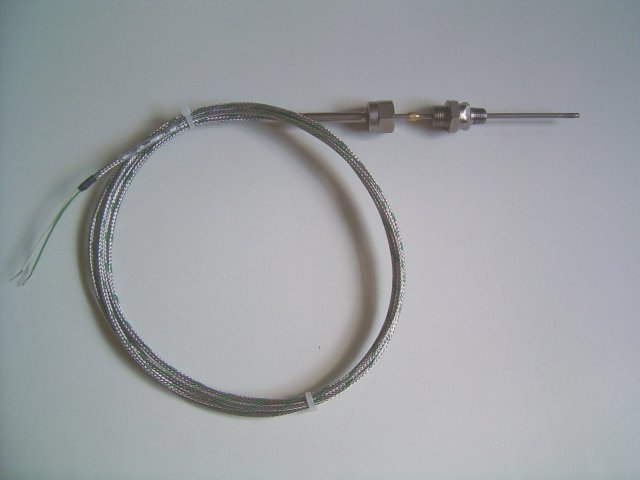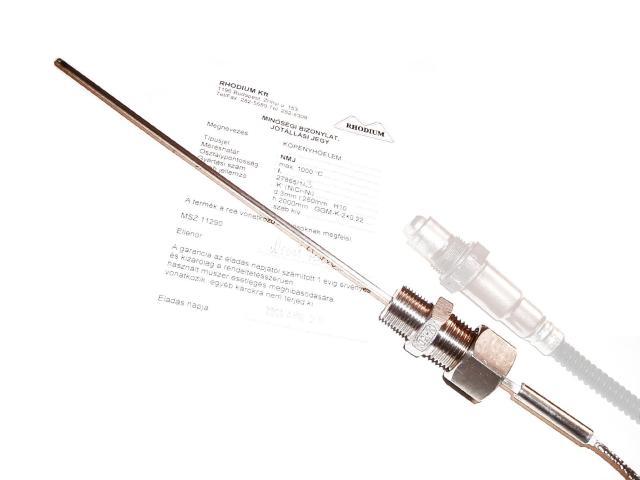For EGT measurement one can use a K type or E type thermocouple.
It is posible to order custom size sensor / fitting (eg. if you already have a thread in the turbine housing), just write it in the order note. Considet that custom size takes appr. 3 weeks (without shipping), so order in advance.
My favorite (see WebShop) K-thermocouple:
- 3mm diameter tip, max 1100C
- 120mm length
- 2.5m cable: max temperature 400C
- nipple for fastening the sensor: 1/8NPT (close to 10x1mm thread, self sealing). Earlier 18x1.5 mm 8mm long was standard (same as WBO2 sensor thread), now the bigger thread only on explicite request. The fitting is often just welded into the exhaust (the sensor is removable of course)
- [Picture of the sensor in the exhaust of a turbo engine. Note that the sensor is bent.] (TODO: drawing)
The 120mm long sensor looks like this:

[[Manual: Basics.Install.Mechanic]]
The longer thermocouple:

The pic shows a longer, 250mm K-Thermocouple and an LSU4 sensor too. The EGT fitting on the picture is same M18x1.5 mm thread as the LSU4, but recently the smaller 1/8" EGT fitting is more popular.
For the curious
There are 2 issues to measure Temperature with a thermocouple:
- amplifying 0..40mV signal requires temperature compensated amplifier (and supply-compensated if possible) and calibrated or low-offset
- the cold junction temperature must be added (either in the analog domain or measured via separate ADC )
GenBoard/VerThree has amplifiers for EGT inputs:
- 2 channels: optional AD597AR (temperature compensated). Normally the sensor wires go to the board, to the AD597AR, since the cold junction temperature is added in the analog domain inside the AD597AR chip. Difference between the AD597AR chip temperature and the (cold) end of thermocouple cable will show up directly as (repeatable) measurement error. There is place for 2 AD597AR onboard, but you need to buy the chips in the WebShop separately.
- midOPA (see GenBoard/VerThree/RescueKit) can be used to amplify sensor input, but onboard temperature (see NTC in the WebShop) must be measured to compensate OPA temperature drift. The cold junction must be measured with separate ADC channel, wether the cold junction is on the board or outside. Note that cold junction outside configuration uses up 3 ADC channels for the first EGT channel instead of the 1 with AD597AR. 1 ADC channel for each other EGT channels after the first (the cold junctions must be common, and the onboard temp is the same, of course). This way is also trickier to set up, and unsupported currently: only mentioned for completeness.
[[Manual: Basics.Install.Maintain]]
Thermocouple connector
Currently, there are no thermocouple connectors in WebShop. Because of the long sensor cable, wire-2-wire is not essential (would be about 14 Euro for the 2 sides). A panel mount connector would be ideal (but I didn't find one): preferrably one that mounts in round drilled hole. Wholesale price should be below 20 Euro for a case-mounted K-thermocouple connector solution.
Target EGT temperatures:
The exhaust parts start melting at around 1650F. There is a web page on the Avweb site where a guy goes into a lot of detail about EGT and CHT temps, with color charts and graphs 8-). Bear in mind that the engines he refers to are mostly redlined at 2700 rpm. The rest of the information is equally valid for airplane and auto engines.
Look here about detonation and temps:
http://www.avweb.com/news/columns/182132-1.html
and especially here for temps:
http://www.avweb.com/news/columns/182084-1.html
AI Nut
Some people claimed he targets 1350F EGT (at max power), others try 1500F for short time. The warning from Bill: Of course without knowing EGT at stoich, this number is fairly, if not totally meaningless when carried over to a different engine.
The wisdom from Dennis:
- The answer to this question is a function of engine design and operating requirements.
- For drag racing, you can peak out at 1600-1750 deg F for short periods.
- We run durability engine tests (6500rpm, full load for 300 hours) at numbers at or around 1500 deg F.
- If you have to protect a catalytic converter, you tend to run richer at high rpm and leaner at low rpm - each OEM has differenct criteria on that regard and nobody talks about what they do - for obvious reasons, I can't either.
- Basically, some engines can run at 1500 and others at 1600 with no ill effects. It really depends on whether the basic engine design will be sensitive to high EGT's or not.
- I know of an engine that runs at 1500 and has no issues whatsoever and another that experiences seat distortion/valve problems at same EGT & load conditions.
- Also, the point on the rpm scale where peak EGT occurs is a factor. Pretty much any engine should endure a peak EGT of 1500 at peak torque - you could probably creep up to 1650 at peak power.
- I won't go into the fuel situation as gas versus alcohol versus "nitro" creates a whole new set of circumstances.
- Valve size plays a factor. Figure out the heat absorbtion area of a 1.910" head diameter exhaust versus a 22mm head diameter on a 4V engine and you can see that the AMOUNT of head absorbed can play a bigger factor that the temp level of the surrounding gasses.
- Although M/S makes pretty sure you have equal fuel, manifolds don't always have equal air distribution. Thus, if you pick the wrong hole to measure, you could have a "great EGT" but still burn parts. How lucky do you feel that you picke the wright hole to judge the whole program by???
- Point being: Asking "what is a safe EGT???" is like asking "what's the price of a tire???" The answer depends upon what you're trying to do and for how long and whether you're using the proper perspective for judgement.
- Sorry to bother you but since I'm no longer registered at M/S, maybe you could pass this empiricle wisdom on.....
Dennis
Some gathered rumors and facts from J�gen Karlsson.
- Exhaust temperature is pretty useless for tuning the fuel delivery on a car but I would never tune a car without it as it show when it?s time to step away from the ideal fuel delivery to cool the engine.
- I also find it useful for tuning the ignition timing, if the exhaust temperature drop when you add some timing it?s a good indication that you went in the right direction.
- One thing that should be noted is that you exhaust temperature drop when the mixtures go weaker then lambda=1.1 (AFR=16.2:1) or so. Also worth noting is that knock is most likely to occur between lambda=1.05 and lambda=0.85. You definitely want to stay away from the entire window if you are boosting a fragile engine. I have heard that many modern engines tend to knock the most at around lambda=0.9, this is also where they produce the most power.
- A few of my friends work at Volvos test and development facility here in Gothenburg. The guys from the lab that I know tend to tune their own turbo cars so that they never exceed 1000C for more then a minute at a time! And their engines stay together most of the time.
- A note taken from an internal Audi education program is that they added a temp sensor on the 2.7l biturbo so that they would not have to resort to tune the car to 950C to maintain a safety margin. By using the temp sensor they can enrich the mixture when they actually go higher then 1000C. Volvo did the same thing on the 16v turbo in the early nineties.
- Note that the engines I have been talking about all have good oil sprayed pistons, sodium filled valves and turbos with an extended temperature range.
- The old Audi fivepots that I used to play around with often pulled exhaust studs or cracked their manifolds when going higher then 800C for a few minutes. I had it pegged at well over 1100C for two minutes without hurting anything. I was impressed that I could cruise at 210km/h without going into the boosted range, I forgot to check the EGT?
As a pole some engines melt pistons and valves at 800C.
J�gen
note for HW-developer's
Some instrutions on 100-1000X amplification (translated sloppily):
- Low offsetet and drift OPA (suggesting chopper balanced??, like: ICL7650, or low noise ICL7652....)
- OPA inputs guard-ed by ground, see applications notes and datasheets of above
- At high amplification rate use low TK resistors, since temperature dependence will distort (0.1% TK-25ppm, Elektrade Ltd in HUN)
- In feedback branch connect a C 220nF...2.2uF parallel with the R. (Makes it slower, but problematic without) (polypropilen - mylar? - or teflon type is the best)
- Use S/D ADconverter (most are applicable to small signals like this)
- Ciao,
- HG
[[Manual: Basics.Install.Mechanic]]
Links
Here is a standalone thermocouple instrument, and will give temperatures upto 1000degC from a K-Type thermocouple.
http://www.squirrelpf.com/msavr/files/data-1.pdf
Its RS catalog number is: 260-167 They cost 50.57 each (ouch, almost as much as a genboard v3.1 with some discount).
EGT-probe at http://www.teamrip.com/accessories.html
1/8NPT -27 thread, there are stainless bungs available too..Looks like the probe is something around 50mm, thread included..
Any suggestions on a sensor? WebShop
Can the sensor wire be bought and welded? It's tough. There are connectors for EGT (where exactly?)
New standard is sensors with longer, 2.5m cable. If the sensor cable cannot reach the AD597AR, I'd rather move the cold junction than attaching several EGT cables.
See also